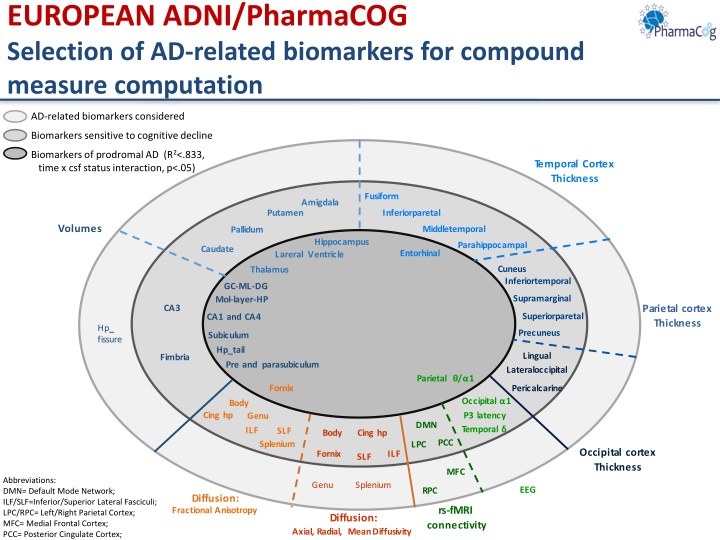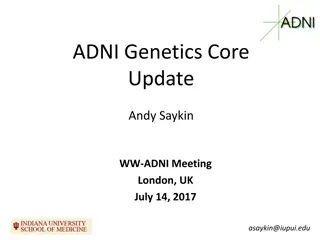
Identification of AD-Related Biomarkers and Disease Progression Predictors
Discover the selection of AD-related biomarkers for computing compound measures, including markers sensitive to cognitive decline and prodromal AD. Explore structural and functional brain biomarkers, blood biomarkers, and biomarker matrices to predict and monitor disease progression in MCI patients with prodromal AD. Delve into research articles exploring the relationship between cognitive function, hippocampal volume, and CSF biomarkers in patients with MCI. Stay informed on the latest advancements in identifying and tracking AD progression.
Download Presentation

Please find below an Image/Link to download the presentation.
The content on the website is provided AS IS for your information and personal use only. It may not be sold, licensed, or shared on other websites without obtaining consent from the author. If you encounter any issues during the download, it is possible that the publisher has removed the file from their server.
You are allowed to download the files provided on this website for personal or commercial use, subject to the condition that they are used lawfully. All files are the property of their respective owners.
The content on the website is provided AS IS for your information and personal use only. It may not be sold, licensed, or shared on other websites without obtaining consent from the author.
E N D
Presentation Transcript
EUROPEAN ADNI/PharmaCOG Selection of AD-related biomarkers for compound measure computation AD-related biomarkersconsidered Biomarkerssensitive to cognitive decline Biomarkers of prodromal AD (R2<.833, time x csf status interaction, p<.05) T emporal Cortex Thickness Fusiform Amigdala Putamen Inferiorparetal Volumes Middletemporal Pallidum Hippocampus Parahippocampal Caudate Entorhinal Lareral Ventricle Cuneus Thalamus Inferiortemporal GC-ML-DG Supramarginal Mol-layer-HP Parietal cortex Thickness CA3 Superiorparetal CA1 and CA4 Hp_ fissure Precuneus Subiculum Hp_tail Lingual Fimbria Pre and parasubiculum Lateraloccipital Parietal / 1 Fornix Pericalcarine Occipital 1 P3 latency Body Cing hp Genu DMN Temporal SLF Body Cing hp PCC Splenium LPC Occipital cortex Thickness Fornix ILF SLF MFC Abbreviations: DMN= Default Mode Network; ILF/SLF=Inferior/Superior Lateral Fasciculi; LPC/RPC= Left/Right Parietal Cortex; MFC= Medial Frontal Cortex; PCC= Posterior Cingulate Cortex; Genu Splenium EEG RPC Diffusion: Fractional Anisotropy rs-fMRI connectivity Diffusion: Axial, Radial, MeanDiffusivity
Best individual biomarker VS Best compound measure Sample size required to detect 30% slowing of atrophy 400 x1.3 = 0,05 Power= 0,80 350 339 Number of patietns 300 Right Lateral Ventricle 250 259 x1.7 Best Compound Measure Vol. of L lateral ventricle Vol. of R lateral ventricle Vol. of L hippocampal tail Vol. of R hippocampal molecular layer 200 x1.6 150 146 100 107 88 68 50 0 24 months 12 months 6 months
Journal of Alzheimers Disease E-ADNI (PHARMACOG WP5) Special issue 1st author *equally contributing authors Variables of Interest Preliminary Titles Last author Predicting and monitoring short term disease progression in aMCI patients with prodromal AD: structural brain biomarkers Structural markers (3T MRI: T1, DTI, FLAIR) 1 Marizzoni M Frisoni GB Functional markers (3T MRI: rsfMRI; EEG: rsEEG, auditory oddball ERP) Predicting and monitoring short term disease progression in aMCI patients with prodromal AD: functional brain biomarkers Jovicich J*, Babiloni C* 2 Frisoni GB Peripheral markers (blood biomarkers: Abeta and innate immunity-related molecules) Predicting and monitoring short term disease progression in aMCI patients with prodromal AD: blood biomarkers 3 Albani D Frisoni GB Biomarker matrices to diagnose and track short term disease progression in aMCI patients with prodromal AD CSF, 3T MRI, EEG/ERP, peripheral biomarkers 4 Marizzoni M Frisoni GB Deadline: July 2017
Dissemination Journal Title Status Author Neurobiology of Aging Relationship between cognitive function, hippocampal volume and CSF biomarkers Association between CSF biomarkers, hippocampal volume and cognitive function in patients with amnestic mild cognitive impairment (MCI). Published May 2017 Nathan et al. Human Brain Mapping Reproducibility of multicentre DTI Free water elimination improves test-retest reproducibility of diffusion tensor imaging indices in the brain: A longitudinal multisite study of healthy elderly subjects. Published Jan 2017 Albi et al. Human Brain Mapping Reproducibility of multicentre rs-fMRI Test-retest reliability of the default mode network in a multi-centric fMRI study of healthy elderly: Effects of data-driven physiological noise correction techniques. Published Jun 2016 Marchitelli et al. J Intern Med. Description of clinical, npsy, and biomarker features at baseline Clinical and biomarker profiling of prodromal Alzheimer's disease in workpackage 5 of the Innovative Medicines Initiative PharmaCog project: a 'European ADNI study'. Published Jun 2016 Galluzzi et al. NeuroImage Reproducibility of multicentre rs-fMRI Longitudinal reproducibility of default-mode network connectivity in healthy elderly participants: a multicentric resting-state fMRI study Published Jan 2016 Jovicich et al.
Dissemination Journal Title Status Author Human Brain Mapping Reproducibility of multicentre automated hippo subfields segmentation Longitudinal reproducibility of automatically segmented hippocampal subfields: a multi-site European 3T study on healthy elderly Published Sep 2015 Marizzoni et al. Neurobiology of Aging Structural markers of progression in murine models Striatum and entorhinal cortex common neuropathological targets in Alzheimer's disease mouse models Published Feb 2015 Micotti et al. NeuroImage Reproducibility of multicentre DTI Multisite Longitudinal Reliability of Tract-Based Spatial Statistics in Diffusion Tensor Imaging of Healthy Elderly Subjects Published Nov 2014 Jovicich et al. NeuroImage Reproducibility of multicentre structural MRI Brain morphometry reproducibility in multi-center 3T MRI studies: A comparison of cross-sectional and longitudinal segmentations Published Dec 2013 Jovicich et al. Drug Discovery Today: Therapeutic Strategies PharmaCog concept of parallel clinical-preclinical validation of markers of progression A new paradigm for testing AD drugs neuroimaging biomarkers as surrogate outcomes homologous in animals and humans Published Oct 2014 Marizzoni et al. Journal of Alzheimer s Disease Review of disease tracking markers for AD Disease tracking markers for Alzheimer's disease at the prodromal (MCI) stage Published Aug 2011 Drago et al.
EUROPEAN ADNI: EPAD Aim: to create a platform for faster and better assessment of drugs for the prevention of Alzheimer s disease (AD), in people with very early or no symptoms at all 3 Major components of EPAD Cohorts/Re gistry (PCs) Proof of Concept (PoC) Study Longitudinal Cohort Study Adaptative trial EPAD Registry N=24,000 EPAD LCS N=6,000 EPAD PoC N=1,500 Active cohorts with non-demented participants >50 years Willingness to have enrolled in EPAD LCS and PoC participants
European Prevention of Alzheimers Dementia Longitudinal Cohort Study (LCS) Prospective Multicentre pan European Longitudinal Cohort Study (LCS) From EPAD registry to EPAD LCS
European Prevention of Alzheimers Dementia Longitudinal Cohort Study (LCS) Clinical Biosampling a) Blood Sample b) Saliva Sample c) Urine Sample d) Cerebrospinal Fluid Sample a) Physical examination b) Medical History c) ENE Cognitive Battery: RBANS, Dot Co unting (NIH Examiner), Flanker (NIH Exami ner/Toolbox), Nameface pairs, Four Montains Task, Virtual Reality Supermarket Trolley d) Geriatric Depression Scale e) State Trait Anxiety Inventory f) Pittsburgh Sleep Quality Index g) Amsterdam Instrumental Activities of Dai ly Living Questionnaire h) Clinical dementia Rating Scale j) Mini-Mental Health Status Examination Neuroimaging a) structural MRI b) fMRI Lifestyle a) Socio-demographics b) Family History of Alzheimer's Dementia c) Lifestyle factors Flexible algorithm deliver accurate disease models to estimate an individual s overall probability of developing AD
European Prevention of Alzheimers Dementia Longitudinal Cohort Study (LCS) December 2019 July 2016 May 2017 N=200 TDC N=700 Swit/Italy N=6000 Europe 1st wave: Edinburgh, Toulouse, Amsterdam, Barcelona Sponsor: University of Edinburgh 2nd wave: Brescia, Paris, Oxford, Lille, Cologne are about to start recruiting FPI: end of summer 2016 So far, around 100 patients (10-12 participants per month) have been recruited
EUROPEAN ADNI: AMYPAD Determine clinical utility of Amyloid PET - Diagnostic value patient management - Risk stratification EPAD long cohort (LCS) - Monitoring treatment clinical trials AMYPAD Consortium 8 academic centers, 3 pharma companies, 2 SMEs and 1 patient organization spread across Europe www.amypad.eu 10
WP3: Diagnostic Study Study Diagram History, Neuropsycological assessment locally adopted Intended dx work up MRI scan or CT if not already available First consultation T0 - V0 (Screening ) and Baseline Screening: Informed Consent, Diagnosis (syndromic), inclusion/exclusion criteria Baseline: Cognition, Anxiety, Depression, Coping skills, Quality of life, Dx confidence, Likelihood that symptoms are due to AD pathology Stratificationin SCD Plus (N=300), MCI (N=300) , Dementia where AD is differential diagnosis (N=300) Randomisation ARM 2 ARM 3 ARM 1 DIAGNOSTIC STUDY CLINICAL ROUTINE Amy PET if chosen Any test Any test, no Amyloid PET Only Amyloid PET Extension of dx work up Additional exams Dx disclosure Etiologic diagnosis & Management Plan ARM 3 : Amyloid PET if chosen Optional: FDG PET, CSF, DaTscan, EEG, others..... T1 (12 weeks from baseline) : data inclusion in eCRF Etiologic diagnosis & Management Plan T2 V1 (6 months from baseline): data inclusion in eCRF Cognition, Anxiety, Depression, Coping skills, Quality of life, Dx confidence, Likelihood that symptoms are due to AD pathology ARM 2: Amyloid PET 8 Months + - 8 weeks Refinement of etiologic diagnosis & management plan Refinement of Dx T3 V2 (13 months from baseline): data inclusion in eCRF Cognition, Anxiety, Depression, Coping skills, Quality of life, Dx confidence, Likelihood that symptoms are due to AD pathology www.amypad.eu 11
WP3: Diagnostic Study Timeline to FPI Approved Draft of the Protocol Informed Consent April 2017 Generation of core clinical document May-June 2017 Generation of Country specific documents for EC/RA submission in 8 different centres Netherlands (Amsterdam) Germany (Cologne) France (Toulouse) Spain UK (Barcelona) Switzerland (Geneva SPONSOR) Sweden (Stockholm) (London, Edinburgh) FPI Estimated October 2017 www.amypad.eu 12
WP4: Prognostic and Natural History Study Study Diagram www.amypad.eu 13
WP4: Prognostic Study Timeline to FPI Approved Draft of the Protocol May 2017 Generation of core clinical document May-June 2017 Generation of Country specific documents for EC/RA submission in 8 different centres Netherlands (Amsterdam) Germany (Cologne) France (Toulouse) Spain (Barcelona) Switzerland (Geneva) UK Sweden (Stockholm) UK (Edinburgh: SPONSOR) (London) FPI Estimated October 2017 www.amypad.eu 14






















